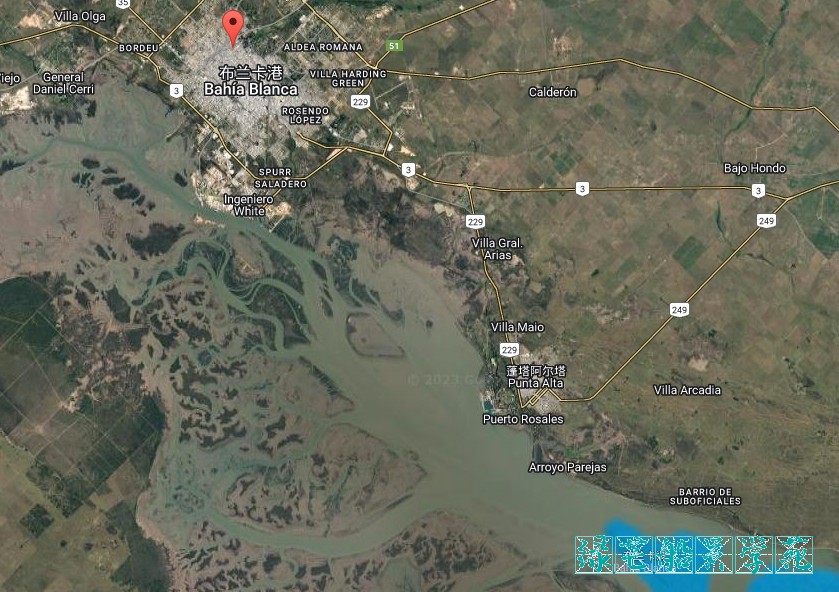阿根廷布兰卡港(Bahia Blanca Port)简介
概述Overview:GPS position: 38°47's, 062°17'W;Port code: ARBHI;Currency: PESO (code: ARS, symbol ARS$);The language is Spanish;Time: GMT-3;Port density: 1.025g/cm3.
一、水文气象 ...
概述Overview:
GPS position: 38°47's, 062°17'W;
Port code: ARBHI;
Currency: PESO (code: ARS, symbol ARS$);
The language is Spanish;
Time: GMT-3;
Port density: 1.025g/cm3.

一、水文气象 Hydrometeorology
In January, the wind direction is mostly N and NW, and the wind is 3-4.Sometimes gusts of 6-7;
In April, the wind direction is mostly SW, W and NW, the wind is 3-4, and the gust occasionally reaches 7.
In July, the wind direction is mostly NW and W, the wind is 4-5, and the maximum gust is more than 8.
In October, the wind direction is mostly N and SW, the wind is 5-6, and the maximum gust is more than 8.
The annual summer thunderstorm weather, an average of about 25 days of thunderstorm weather per year;
Influenced by the South Atlantic Current, it flows to W-SW with a velocity of 0.5-1.0 knots.
The river is reciprocating flow(往复流), the maximum velocity of 2-3 knots.
The harbour is a semi-diurnal tide. When it is affected by a sustained gale (持续大风)(or a force 8 or above), the tide height will decrease or increase accordingly. After 3-5 hours of gale force, the tide height will be significantly affected, and the maximum tide height will increase or decrease by about 1.5 metres.
If the wind comes from the direction of WNW, N, and NNE, the tide height will decrease, and if the wind comes from the direction of E, S, and W, the tide height will increase.
二、锚地和限制区域Anchorage and restricted areas
The anchorage is distributed on the north side of the channel, including anchorage areas A, B, C, D and E, and there is an outer anchorage area(Roadstead港外锚地) on the northeast side of the NO. 2-No.3 buoy.
There is also a restricted area for access to ports, anchorages and waterways that should be given special attention.
A: Water depth of 9.7 meters, emergency tide use;
39°04.16'S 061°48.60'W
39°05.20'S 061°46.49'W
39°06.35's 061°46.60'W
39°04.86'S 061°49.20'W
B: Water depth 10.9 meters, emergency and ship draft 10 meters above the tide use;
39°03.13'S 061°50.59'W
39°04.10'S 061°48.70'W
39°04.81'S 061°49.29'W
39°03.70's 061°51.09'W
C: Water depth 10.5 meters, emergency tide use;
38°59.10'S 061°53.90'W
38°59.50'S 061°54.20'W
39°00.30'S 061°51.10'W
39°00.55'S 061°51.70'W
D: Water depth of 10.0-17.0 meters, emergency and ship draft more than 10 meters for tide use
38°58.30'S 061°56.00'W
38°59.00'S 061°54.00'W
38°59.40'S 061°54.20'W
38°58.80's 061°56.20'W
E: Water depth 12.0 meters, emergency and ship draft 10 meters above the tide use;
38°58.30'S 061°57.03'W
38°58.05'S 061°55.05'W
38°58.05'S 061°57.05'W
38°59.01'S 061°55.09'W
READSTEAD: The water depth is 13.0 meters, the base of berthing plan for tide(侯潮等靠泊船使用): fine sand(底质:细沙);
39°17.00's 061°36.83'W
39°17.00'S 061°30.00'W
39°19.99'S 061°32.93'W
The restricted areas are the following four connections:
a)39°00.01'S061°37.01'W
b)39°05.00'S061°40.01'W
c)39°02.01'S061°47.03'W
d)38°58.05'S061°50.11'W
三、引航和航道Pilotage and navigation channels
1. Pilotage(引航):
The port is mandatory for all foreign ships to pilot, at least 48/24 hours before the arrival of ETA, and send the pilot application report, if there is a berthing plan agent will inform the detailed piloting information, usually the pilot embarks at the CANAL PRINCIPAL channel NO.11 light float, required to be 2 meters above the water surface of the composite ladder(gangway+pilot ladder组合梯). Available via VHF16&12, pilot stations are ESEM S.A and DONMAR S.A.
If there is no berthing plan, you can contact CONTRASE (TRAFFIC CONTROL AND SAFETY SYSTEM), VHF16&73 to apply for berth outside the port and report the relevant information of the vessel.
2. Channel(航道):
CANNAL RINCON:
Buoy RINCONLIGHTBOY-NO.4, distance 10.5NM, depth 12.80 meters, channel width 1800 meters;
CANNAL PRINCIPAL:
Buoy NO.4- NO.12, distance 18.0NM, depth 12.80 meters, channel width 190 meters;
CANNAL DEL TORO:
Buoy NO.12- NO.16, distance 8.0NM, depth 12.80 m, width 190.0 m;
CANNAL PRINCIPAL:
Buoy NO.16- NO.22, distance 10.8NM, depth 14.0 m, width 190.0 m;
INGERIERO WHITE:
Buoy NO.22- NO.32, distance 11.0NM, depth 11.80 meters, width 190.0 meters.
四、泊位情况 Berth situation
The Port Blanca berths have four berths and two SPMS on the north side of the river:
PUERTO NACIONAL, PUERTO GALVAN, PUNTA ANCLA, PUNTA CIGUENA, PUERTO ROSALES(SPM PUNTA Ciguena & Ancla).
There are 26 berths for reliable ocean-going ships, reliable bulk carriers with a maximum length of 270 meters and a water depth of 15.2 meters, and oil tankers with a maximum length of 284 meters and a water depth of 13.8 meters, as well as container ships and general cargo ships.
五、注意事项 Precautions
1. Before arriving at the port, it is necessary to have a clear understanding of the situation of the fairway in the Bay of Blanca, and make a detailed entry plan. Before entering the fairway, the main engine, auxiliary engine, steering engine and anchor machine/windlass of the ship are repaired and maintained to ensure that there is no machine failure in the waterway(航道).
2. The entering ship must sail to the NO.11 light buoy by itself before the pilot can board;
From RINCON LIGHT to NO.11 for 26 nautical miles, the ship passes through EL RINCON and the CANAL PRINCIPAL, a narrow channel only 190 metres wide and affected by a tidal current of about 1 knot.
There are two anchorages "A" and "B" on the north side of the pilot station, in which there are more tide ships, the captain should exercise caution and reasonably control the ship speed(谨慎操纵控制速度), and the ship dynamics(动态) can be understood through(沟通) "VHF" and "VTS" to facilitate early coordination and avoidance.
3. In addition, the CANAL DEL TORO Channel, CANAL PRINCIPAL Channel and CANAL INGERIEO WHITE Channel are narrow with a width of 190 meters. In particular, the maximum tidal flow in the CANAL DEL TORO section can reach 2.4 knots. Bridge resource management should be used to coordinate with the pilot to ensure navigation safety.
4. There is a big difference between the tide table and the tidal information provided by the pilot.
Especially in the rainy season, the channel water depth may be reduced due to the impact of silt(淤泥), the captain can understand the latest information through the agent, the port and other relevant channels, reasonable control of the sailing draft, always maintain at least 10% of the ship's draft for UKC(富裕水深).
5. For ships loading grain in this port, the ship should be washed and prepared in advance to meet the loading requirements of the port. After arriving at the port, all crew members should be on standby to cooperate with the port side to conduct holds inspection, so as to prevent the high cost of holds inspection from failing to pass.
6. During anchoring and berthing, pollution prevention work should be done, all deck cuppers(甲板下水孔) on the main deck should be blocked, and any garbage and oily water、 sewage should be prohibited from discharging.
In addition, the ship's sewage sea valve must be closed and sealed before it reaches the country's waters, and the ballast water must be replaced and reported strictly as required.
7. During berthing, each rope lines should be properly hung rat-gurad, the gangway should properly hang the safety net, and the on-duty of the ladder must strictly control the boarding of personnel.
8. Both the wharf and the anchorage can supply fresh water, need to contact the agent in advance, the wharf has fresh water pipelines, need to provide fresh water pipes on board can supply fresh water 10 tons per hour, if the supply of fresh water in the anchorage, need to pay transportation costs.
9. Social security at night is very poor(本港夜间社会治安很差), especially the robbery and theft rate of Asian people is very high(特别对亚洲面孔的人的抢劫和偷渡), so you should be careful when going out at night.
It is recommended to carry as little cash as possible on shore, avoid wearing valuable jewelry, and keep money and seafarers' documents separate.
10. When entering or leaving the port or berthing, sandstorms sometimes(沙尘暴) occur, and dry westerly winds from the Andes Mountains(安第斯山脉) suddenly blow, forming a moving cloud of fine sediment(形成一种由细泥沙构成的流动云团) known locally as the Pampero Sucio(当地叫做“尘沙潘派洛风”). Ships should be prepared for such emergencies.
- 发表于 2023-11-19 11:58
- 阅读 ( 508 )
你可能感兴趣的文章
相关问题
0 条评论
请先 登录 后评论
文件生成中...
请稍候,系统正在生成您请求的文件
链接已复制到剪贴板

付费阅读
阿根廷布兰卡港(Bahia Blanca Port)简介

支付金额:¥0.00
扫码过程中请勿刷新、关闭本页面,否则会导致支付失败
购买后请立即保管好,30天后需重新付费。

付费下载
阿根廷布兰卡港(Bahia Blanca Port)简介

支付金额:¥0.00
扫码过程中请勿刷新、关闭本页面,否则会导致支付失败
购买后请立即保管好,30天后需重新付费。
请点击下载或复制按钮进行操作
